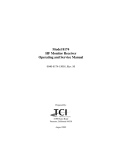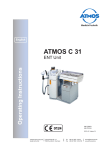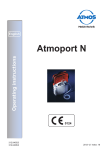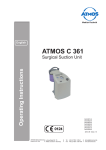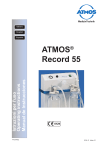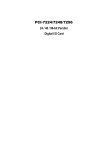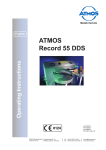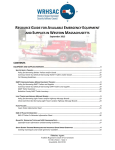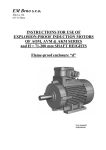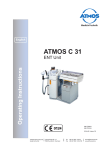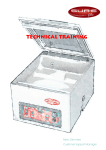Download ATMOS S-351 Suction Pump Service Manual
Transcript
MedizinTechnik ... for a better life English Serviceanleitung ATMOS S 351 ATMOS S 351 Natal FO.04 ATMOS MedizinTechnik GmbH & Co. KG Ludwig-Kegel-Str. 16 79853 Lenzkirch / Germany Tel. +49 (0) 7653 / 6 89-0 Fax +49 (0) 7653 / 6 89-190 [email protected] www.atmosmed.de Contents 1.0 1.1 1.2 1.3 1.4 Page General description................................... 3 Valid operating instructions .......................... 3 Information on manufacturer ........................ 3 Exclusion of liability ...................................... 3 For your safety ............................................. 3 2.0 Installation.................................................. 4 3.0 3.2.3 3.2.4 3.3 3.4 3.5 3.5.1 3.5.2 Unit function and construction of the unit...................... 4-12 Functional description .................................. 5 Description of sub-assemblies ..................... 5 Housing ........................................................ 5 Collection jar system with hose connections and bacterial filter ..................... 5 Internal components ..................................... 6 Electronics ............................................... 7 - 8 Allocation of wires to the plug ...................... 9 Test and measuring points ........................... 9 Service Mode ............................................. 10 Service Level 1 ........................................... 10 Service Level 2 .................................... 10 - 12 4.0 4.1 4.2 4.3 4.4 Changingparts.................................. 13-15 Removal and fitting of the housing............. 13 Removal of the pump module .................... 13 Membrane and valve change ..................... 13 View of pump....................................... 14 - 15 5.0 5.1 Trouble-shooting...................................... 16 General errors ............................................ 16 6.0 6.1 6.1.1 6.1.1a 6.1.2 6.1.3 6.1.4 Maintenanceandrepair.................... 17-34 Test procedure ........................................... 17 Visual inspection ........................................ 17 Suction device-setting-locking .................... 17 Electrical testing .................................. 18 - 19 Functional test of ATMOS S 351 ......... 20 - 23 Functional test of ATMOS S 351 Natal: ......... Vacuum extraction ............................... 24 - 26 Functional test of ATMOS S 351 Natal: Suction ................................................ 27 - 29 3.1 3.2 3.2.1 3.2.2 6.1.5 2 7.0 SpareParts........................................ 35-36 8.0 Technical Specifications.......................... 32 9.0 9.1 Conversion instructions.......................... 33 Trolley......................................................... 33 10.0 Annex(Plans).................................... 34-38 1.0 General description The ATMOS S 351is a surgical suction unit which is used in medical ranges to remove bodily fluids (secretions) and rinsing fluids by means of a vacuum generated in the suction system. The variants of the ATMOS S 351 are used in obstetrics, during eye operations and for intermittent drainage. 1.1 Valid operating instructions The ATMOS S 351 is manufactured in 3 variants: 1.3 ATMOS assumes responsibility for the unit, as far as safety, dependability and functionality are concerned, only if – assembly, readjustment, modifications, extensions or repairs are carried out by ATMOS or by persons authorized by ATMOS, – only original ATMOS parts are used and, – the unit is used in compliance with the operating instructions. 1.4 • ATMOS S 351 • ATMOS S 351 Natal The ATMOS S 351 Natal provides for a comfortable realisation of vacuum extractions. Exclusion of liability For your safety Please also pay attention to chapter 2.0 "For your safety" in the operating instructions. Information which is of particular interest to the user is printed in a box throughout this manual. ATMOS S 351, S 351 Natal Software control Software, CAN Hardware control Operating instructions: ATMOS S 351 ATMOS S 351 Natal Currentissue 2.0 (or higher) – 1.1 444.0405.A 444.0401.A The operating instructions relating to the ATMOS S 351 form part of these service instructions. The persons authorized for service work must be familiar with the contents, the kind of installation, the start-up as well as the operation described therein. 1.2 Information on manufacturer Further information, accessories and spare parts are available from: ATMOS MedizinTechnik GmbH & Co. KG Ludwig-Kegel-Straße 16 79853 Lenzkirch Deutschland Tel. + 49 (0) 76 53 / 6 89-0 Fax: + 49 (0) 76 53 / 6 89-190 + 49 (0) 76 53 / 6 89-493 (Service Center) [email protected] www.atmosmed.de Before opening the ATMOS S 351 for service work, switch off the unit and remove the power cab- Maintenance and/ or opening and repair of the ATMOS S 351 may be carried out only by an expert authorised by the manufacturer. When doing this, technical and hygienic protective measures are to be taken. When assembling the housing, particular care is to be given to the electric cabling and the silicone hose. These must not be bent sharply or get caught. If necessary, the lines should be retracted somewhat into the rear housing shell. In case of improper maintenance or repair of the appliance and the use of non-original parts the product liability of the manufacturer will become forfeited. When opening the appliance during the period of guarantee the guarantee given by the manufacturer will be forfeited. When the appliance is decommissioned at the end of its service life and is to be disposed of, the components are to be given separately into the various recycling processes. The same regulations are to be observed concerning the disposal of replacement parts. 3 2.0 Installation See chapter 4.0 "Installation and commissioning" in the operating instructions. 3.0 Unit function and unit construction ATMOS S 351 Housing Starting valve Exhaust air valve Pump Silencer (in the housing) Connecting nipple Fan Buzzer Display and keyboard Pressure sensor Mains input Overflow contacts, right Fig. 1. Block Diagram 4 Processor board Overflow contacts, trolley Overflow contacts, left Foot controller connection 3.0 3.1 Unit function and unit construction Functional description The main part of the suction unit is the diaphragm-type pump (4). The motor of the pump is controlled by the processor board (14). A pressure transducer (15) delivers the actual vacuum to the processor board (14). The pump (4) is driven until the desired final vacuum is shown in the safety glass and in the collection jar. With the help of the vacuum generated, liquid passes through the suction hose into the collection jar. A level monitor (overflow contacts (25, 27, 29) checks the resistance between double socket nipple and an electrode fitted in the collection jar lid. If the resistance changes (by the increasing liquid level in the collection jar) the pump (4) is shut down and an acoustic signal is given by the buzzer (32). Only when the double socket nipple is removed and put into another collection jar is the suction unit again ready for service. The vacuum can be selected by 3 push buttons. A further way of controlling the vacuum is with the foot controller. This is connected to the sub-D-connection bush (22). If vacuum is to be reduced, the exhaust air valve (3), which is controlled by the processor board (14), opens. A temperature monitor (16) monitors the internal temperature of the suction device. This controls the installed fan (13) when required. If the temperature rises above a certain limit (65ºC) then a warning is given. If the 2nd limit is exceeded (85ºC) the unit is shut down and a corresponding fault indication is given. The variant ATMOS S 351 and ATMOS S 351 Natal have additional functions, which allow vacuum creation and reduction over a predetermined time. When using accessories, which are not provided especially for the ATMOS S 351 or its variant, functional limitations may occur (overflow recognition, short circuit). 3.2 Description of the sub-assemblies The ATMOS S 351and its variant are made up of the following components: – housing – collection jar system with hose connections and bacterial ilter – internal components (pump, processor board,...) – electronics 3.2.1 Housing The housing of the ATMOS S 351 or its variant is made of plastics (ABS UL).The main switch, the operating and indicating strip, the connection bushes, the jar fixings (overflow contacts right (29) and left (25)) and the fastening nuts for the trolley (overflow contacts on the trolley (27)) are fitted on the housing. 3.2.2 Collection jar system with hose connections and bacterial filter The collection jars which can be supplied in various sizes and materials (see technical specifications) are put into the mountings provided. The collection jar lids then contact the rails. As a result an electrical overflow protection is provided by the overflow contacts (25, 27, 29). The processor board (14) assesses the signals appropriately. The electronics differentiate between ”no existing overflow” (= resistance close to ∞), ”overflow present” and a ”short circuit” (< 100 Ω). In addition on the signal input of the trolley (27) the trolley is recognised. This is done by a resistance installed in the trolley (1 MΩ ± 20%). Please note that if using an older trolley the resistance may not yet be installed (see Page 38: Trolley for ATMOS S 351 or modify its variant). A hydrophobic bacterial filter must be fitted in the airway in front of the connection nipple (1) which prevents the secretion being sucked into the pump and thus avoids a bacteria contamination of the space inside the housing. There are two ways of doing this: 1. Use of the bacterial filter that is included in the scope of supply. This filter is fitted in the pipework between the connection nipple (1) and the overflow container. 2. Use the bacterial filter that can be obtained as an accessory in the overflow container. This bacterial filter has a longer life and can be autoclaved. Further details on this are given in the Operating Instructions. 5 3.0 Unit function and unit construction 3.2.3 Internal components (2) Pipework on the vacuum side The pipework on the vacuum side connects the connection nipple (1), the exhaust air valve (3), the pressure transducer (15) on the processor board (14) to the pump (4, vacuum connection). The pipework is manufactured complete with silicone hoses. (14) Processor board The processor board serves to control and monitor the ATMOS S 351. It forms the central unit. On the processor board there is the processor, the power supply for the electronics, the pressure transducer (15) and the temperature transducer (16). (3) Exhaustairvalve The exhaust air valve (3) serves to reduce the vacuum, if the system (collection jar, etc.) is shutdown. The valve is controlled by the processor board (14) with 12V dc. The function can be tested in Service Mode 2. (18) Display and keyboard The display and the keyboard are directly connected to the processor board (14) with the ribbon cable (17). On the ribbon cable (17) there are 2 ferrite cores for fault clearance. The display is a graphic LC display with 128 x 64 pixels. The lighting is done by means of LEDs. (4) Pump The pump (4) is supplied with mains voltage through the processor board (14). The processor controls the pump (4) until the preset vacuum is reached. When the vacuum is reached the power supply is switched off. The function can be tested in Service Mode 2. (5) Startvalve The pump (4) does not start automatically under vacuum. Therefore, when necessary the vacuum in the pumping head of the pump (4) is reduced by the start valve. Since the valve is located in the intermediate piping of the pump, no reduction of vacuum occurs on the vacuum side. The control of the valve (5) is done by the processor board (14). The processor uses the running signal of the pump which is reported by the control wire (11) to the processor board to recognise a start. (6) Pipework on the pressure side The piping on the pressure side connects the pump (4) with the silencer (7). The piping is made of silicone hoses. (7) Silencer The silencer is integrated into the housing. The exhaust air hose (6) is clamped in the silencer housing and secured with 5 screws and a cover plate. Noise absorbing padding is fitted in the silencer housing to absorb the noise. The air passes out of the back of the housing to the outside. (13)Fan The fan serves to cool the pump (4) and generally to cool the inner space. The fan is supplied with 12V dc by the processor board (14). The fan switches on at a temperature of 45°C and off at a temperature of 40°C on the temperature transducer (16). 6 (22) Foot controller connection In the standard component ATMOS S 351 the connection is done directly through cable (23) to the processor board (14). The foot controller connection consists of a 9 pole Sub-D-Bush. (25,27,29) Overflow contacts (left, trolley, right) The overflow contacts are connected through the connection wires (24, 26, 28) to the processor board (14). The overflow recognition is done by a resistance measurement. (30)Mainsinput The mains input consists of a cold device connection box with integrated fuses and an EMC-filter. In addition a potential equalisation bush is connected here. 3.0 Unit function and unit construction 3.2.4 Electronics The description is done by means of function blocks. • Block 1 Potential separation and production of 12Vdc: The supply voltage is connected at the entry to the block. There is a switch to switch over between 115 and 230V ac. The transformer has an insulation designed for a voltage of 4kV and supplies an output voltage of 18V ac. The secondary winding is protected by a fuse (0.6 AT). A bridge rectifier is fitted to rectify the ac voltage. • Block 8 Motor rotation monitoring: A reflex light barrier is used to check whether the motor is started in the switched on condition. The reflex light barrier consists of an LED and an open collector exit. The light diode is fed through a pre-resistance of 5V. The voltage differences on the open-collector-exit are assessed by the comparator circuit of the OP2 and so prepared that a rectangular signal is made available to the controller. • Block 2 Control of the motor: The motor is connected through a semi-conductor relay. This semi-conductor relay has an insulation designed for 4kV. The control of the relay is achieved directly from an output of the controller. If the input signal of the motor is low, the motor is turned on. • Block 9 Control of valves and fans: The two valves (start and exhaust air) as well as the fans are connectedwith a FET. The loads lie on one side on +12V and are, if necessary, pulled with an FET to GND. The FETs are controlled directly by the controller. Two other FETs ensure that the intake and outlet air valves cannot be connected while the reset signal produced from the reset module is on. BYV27 diodes are used to prevent radio interference. • Block 3 Control of the 5V dc: The 5V dc is controlled by an LM 2574 switch regulator. The regulation is done by back coupling, which by means of a voltage divider is taken back to the feedback of the switch regulator. The switch regulator is short circuit proof. The voltage is smoothed by capacitors. • Block 4 Control of the 12V dc: The 12V dc is controlled by an LM 2574 switch regulator. The regulation is done by back coupling, which by means of a voltage divider is taken back to the feedback of the switch regulator. The switch regulator is short circuit proof. The voltage is smoothed by capacitors. • Block 5 Production of the negative 12V supply: The negative voltage is produced by a charging pump (IC 7660). It is fed by the positive 12V. • Block 6 Reference voltage: The 2.5V reference voltage is produced by a low power band gap diode. The diode has a temperature coefficient of 50 ppm. All AD converter values are based on this reference voltage. • Block 7 Low pressure measurement: A silicon transducer is fitted to measure the low pressure. The measuring bridge of the transducer is fed with a constant voltage. This constant voltage is produced by means of an amplifier and the reference voltage. Usensor = 10.025 V In addition the measuring bridge is evaluated by means of a difference amplifier. The difference amplifier amplifies the signal, so that 1 bar under pressure corresponds to 2.5V. • Block 10 Brightness control of the LC - display: The brightness of the LC display can be controlled with the controller. The current through the LEDs to light the display is controlled through a constant current source. This constant current source is produced by means of a shunt (R33) and an operation amplifier. The target value for the current source is given by the PWM signal of the controller. • Block 11 Indicator: The connection to the indicator board is done by a 26 pole ribbon cable. The control of this LC display and the two LEDs as well as the inputting of the push buttons is done by means of this ribbon cable. The control of the LCD graphic display is done by means of the data bus and some generated control signals. The LEDs lie on one side at +5V and are on the other side pulled through a resistance with the controller to GND. The push buttons are held with a Pull Up to +5V. If a push button is pressed, the level falls to GND and is registered by the controller. • Block 12 Overflow contacts: There are 3 overflow sources: - overflow right - overflow left - overflow trolley The overflow contacts are supplied from the reference voltage through a resistance. The other side of the contact is read with an AD converter of the controller. If the resistance between the contacts is reduced, then the voltage at the AD converter increases and can be detected by the controller as safety glass. The resistance values must not be reduced! 7 3.0 Unit function and unit construction • Block 13 Temperature monitoring: A PTC temperature transducer is used to monitor the temperature in the ATMOS S 351 or its variant. This temperature transducer is read by the internal AD converter of the controller. Thus the fan can be switched on when necessary or a high temperature reported. The following voltage values are produced at the input of the AD converter. Temperature 20°C 40°C 60°C 80°C Voltage 1.225 V 1.322 V 1.412 V 1.496 V Table 3: Temperature values • Block 14 CAN connection: Is not used. • Block 15 Buzzer: The buzzer for acoustic output of warning signals is switched with an FET from the controller. • Block 16 Foot controller: The foot controller is read with the help of the AD converter. In order to guarantee a voltage at the input of the AD converter of 0-1.9V a pre-resistance of 15 kOhms is used. The resistance R35 is used to recognise whether a foot controller is attached. • Block 17 EEProm: Various settings are stored in the EEProm 93LC66B. The communication with the EEProm is done by means of a serial SPI-bus. • Block 18 Controller: An 80C552 made by Philips is used as the controller. The controller possesses the following features: - 80C51 core - 256 x 8 internal RAM, externally upgradable to 64k - 3 independent timers - 8x 10 bit AD - converter input - 2x 8 bit PWM signals - 5x 8 bit 1/O - Ports plus an 8 bit inlet port (ADC) - a UART - watchdog on chip - 24 MHz type • Block 19 Oscillator: The oscillator is produced by a quartz crystal and 2 capacitors. The cycle frequency is 24 MHz. 8 • Block 20 Adress latch: An IC 74HC573 is used to latch the lower 8 address wires (A0-A7). First the addresses are given over the combined data/address bus and intermediately stored by the 74HC573 before the data is read in or read out over the data bus. • Block 21 Eprom: An Eprom 27C512 is fitted as program memory.The eprom has a storage capacity of 512 kbits and is organised in 64k x 8 bit. • Block 22 RAM: An RAM HY6264A is fitted as volatile memory. The RAM has a storage capacity of 64 kbit and is organised in 8k x 8 bit. • Block 23 Address decoding: A 74HC00 is used for the address decoding for the control of the LC display. This decoding circuit has several functions: - The RD signal is inverted. - The enable signal is generated by the connection of the RD, WR and A15 signals. • Block 24 AD-transducer setting: This circuit part serves to adjust and filter the AD converter signal. An RC member filters the signals. A Z-diode protects from over voltage. • Block 25 Reset unit: The reset-unit TC1232CPA has 3 functions: 1. Voltage monitoring: If an input voltage of 4.5V is exceeded, the TC1232 sends a reset signal to the controller. 2. Watchdog function: A port is continually toggled by the controller. If this toggeling is set for a time of more than 150 ms, the unit reports a reset to the computer. 3. Manual reset: If the J1 is short circuited the unit sends a reset. 3.0 Unit function and unit construction 3.3 Allocation of wires to the plug Foot controller Pin 1 2 3 4 5 6 7 8 9 Housing Designation Type of signal GND Low voltage Schleifer potentiometer Supply potentiometer Screening Low voltage Low voltage Earth Allocation of wires to the pins of the foot controller 3.4 Test and measuring points The following measuring points are available on the control board: Designation MOTOR SENSOR REF RST -5V +5V +12V GND Signal Speed of the pump Vacuum (amplified) Reference voltage Reset Negative supply 5 V supply 12 V supply Mass/earth Type of signal (valve) 5 v, rectangular 0 - 2.5 V 2.5 V 0 / 5 VDC - 5 VDC + 5 VDC + 12 VDC 0 VDC Remarks 2.5 V at 1 bar Control board measuring point 9 3.0 Unit function and unit construction 3.5 Service Mode The ATMOS S 351 or its variant differentiate between 2 Service Levels: • Service Level 1: Serves to set the suction device. This level is described in the Operating Instructions. • Service Level 2: Serves to support the service. 3.5.1 Service Level 1 With the ATMOS S 351 Natal you get into the Service Level 1, if you hold depressed the extraction cup key or the eye key during starting; The additional functions of Service Level 1 of ATMOS S 351, ATMOS S 351 Natal is described in detail in the Operating Instructions. With the ATMOS S 351 Natal you get into the Service Level 2, if you hold depressed the suction bell key or the eye key together with the ”End” key during starting. Fig. 2. Start picture Service Level 2 10 With the ATMOS S 351 you reach Service Level 1 if you hold the "Standby" key down when switching on. Functions of Service Level 1: • Adjust Unity: The units of the indicator can be changed over here: mbar / kPa / mmHg. • LCD Brightness: The LCD background lighting can be adjusted here (0 to 25) • Adjust Intermit: Adjustment of the Intermit-mode can be done here. Read the description of this in the Operating Instructions. 3.5.2 Service Level 2 Overview of the functions of Service Level 2: a) Show Errors: Any errors that have occurred, including the error history, can be seen here. b) Clear Errors: Serves to delete the error memory. c) Test Airtight: The system tightness can be tested here. d) Test Hardware: The main functions of the suction device can be directly tested. With the ATMOS S 351 you reach Service Level 2 when you hold the ”standby” and the intermittent key depressed when switching on: Select with the arrow keys the corresponding functions and confirm them by pressing on the ”Max” key. In order to leave the service level press the ”Standby” key and the ”Extraction cup” key on ATMOS S 351 Natal 3.0 Unit function and unit construction a) Show Errors Number of errors that have occurred Indicated error Error designation Fig. 3. Error memory The error history can be used to make the search for errors easier: A maximum of 10 errors can be stored. If more than 10 errors occur then the first 9 and the last error that occurs are stored. The last error is always at the start (Error 1). The following errors are recognised and displayed by the ATMOS S 351 or its variant: Error Description of error Key error A key is jammed or is depressed for more than 7 seconds Motor sensor When the motor is switched on the rotation sensor gives no feedback after 4 seconds The pressure measured is outside the range. Pressure sensor Temperature Overflow short circuit Reaction of the ATMOS S 351 or its variants The device goes into emergency operation, error message is entered in the error memory. The device goes into emergency operation, error message is entered in the error memory. The device goes into emergency operation, error message is entered in the error memory. Possible sources of the error Key jammed Parts on the keyboard - If the temperature exceeds 85ºC or falls below -5ºC an error message is given, which is only erased when the temperature falls below 80ºC or rises above 0ºC. An acoustic signal sounds every 10 seconds. The high temperature symbol appears on the display. The pump is switched off. The error message is entered in the error memory. - If the contacts of the overflow are short circuited (<100Ω) an error message is given Every 10 sec error message in the display as well as buzzer for 1 second. The error message is entered in the error memory - - Motor does not turn Motor sensor defective or not correctly positioned Motor control defective Hose on the wrong sensor nipple Pressure sensor defective Pressure sensor not connected Temperature in the suction device is too high Ventilation slot blocked Surrounding temperature too high Fan does not work Temperature transducer defective Contacts shorted Error codes b) Clear Errors When the errors have been resolved the error memory needs to be cleared again. Choose the ”clear errors” function for this. c) Test air tightness of system This can test to what extent the total system is tight. Fig: 4. Tightness test - Start diagram Connect all hoses/containers on the ATMOS S 351 or its variant to be tested. Close the suction hose and start the test with the ”max” key. It takes place as shown on the adjacent display. 11 3.0 Unit function and unit construction The ATMOS S 351 or its variant begin to create vacuum (Phase 1, as shown). Then there is a waiting time (Phase 2, ”wait”). Fig. 5. Tightness test - Test The test result is shown with a box. Then start a new test run with the ”Max” key or end the function with the ”Standby” key, ”Extraction cup” key with ATMOS S 351 Natal. The example shows a tight system. System is tight System is leaking Fig. 6. Tightness test - Result d) Test Hardware Fan Fig. 7. Test hardware 12 This function serves for the targeted testing of individual components. Chose the function to control the valves, fan or pump directly: • Fan on/off with the "intermittent" key for the ATMOS S 351, with the "extraction cup" key for the ATMOS S 351 Nata; • Exhaust valve on/off with the "arrow left" key (valves – exhaust) • Starting valve on/off with the "arrow right" key (valves – starting) • Pump on/off with the "max" key (pump) 4.0 Changingparts Clean the ATMOS S 351 or its variant before you carry out repairs. Take suitable precautions (to prevent contamination). 4.1 Removal and fitting of the housing Removal: a) Remove the mains cable at the back of the device. b) Remove the two cover plates on the back of the handle. c) Remove the 2 connecting screws on the handle (Torx). d) Remove the 2 connecting screws on the lower side of the housing forward shell. e) Pull the housing shells from one another. Assembly: After carrying out the repair assemble the ATMOS S 351 as follows: a) Push the two housing halves together. b) Push the cable loom (between both housing shells) as far as possible into the back half of the housing. c) Now slide the two halves of the housing completely together. Take care that you do not pinch/clamp either the hose or the cable. d) Screw in all fastening screws again. e) Insert the cap again. 4.2 Removal of the pump module a) Remove the two fixing screws on the pump console. b) Remove the 6 fixing screws on the silencer (sheet above the set). c) Pull the pump module out forwards. d) Remove if required the corresponding cable/hoses. 4.3 Membrane and valve change Remove the pipework from the pump. Remove the four socket headed screws (1a or 1b) of the pump head (2a or 2b) (Figure 8, Page 14). Clean the diaphragm disk (3); check whether the diaphragm (4) has fractures, if necessary renew it. For this, remove the socket headed screw 5. Remember when assembling that the membrane is assembled in the lower dead point (Figure 10, Page 15). Remove the three countersunk head screws (6a or 7a) on the valve head, the valve plates (6c or 7b) and O-rings (6b or 7c). Clean valve heads and complete pump head with spirit, fit new valve plates and O-rings and assemble the aggregate in the reverse direction (Figure 11 and Figure 12, Page 15). In addition the noise absorbing material must be changed. In no case may the connecting rod be disconnected from the motor shaft, since this can result in out of balance running or very bad behaviour on starting. The right and left pump heads are different and must not be interchanged. Take care when assembling that the hoses are correctly connected. For new pumps: When fitting a new pump you must remove the stopper on the motor transducer connection (8). Then press the motor transducer into the hole. Take care that the light fields lie one above the other (not side by side). In addition, the transducer must not be on the flywheel. 13 4.0 Changingparts 4.4 View of pump 14 2b 13 2a 1a 2a 1a 9 1b 10 1b 1a 1a 8 1b 1a Fig. 8. View of the complete pump from the front 1a 1b 2a 2b 8 9 10 13 14 Fixing screws pump head right Fixing screws pump head left Pump head right ............................................ 069.0065.0 Pump head left .............................................. 069.0064.0 Connection for motor transducer Starting valve Exhaust air valve Vacuum side 12 Pressure side 11 Fig: 9. View of pump from the valve side 9 10 11 12 Start valve Exhaust air valve Vacuum connection Pressure connection (to the damper) 10 14 9 4.0 Changingparts 5 5 3 3 4 4 Fig. 10. Pump without pump head 3 Diaphragm disk ...................................069.0036.0 4 5 Membrane ...........................................069.0025.0 Fixing screw for diaphragm disk 7c 6b 6a 6a 7a 6a 6c 7a 7a 7b Fig. 11. Pump head left (internal view) 6a 6b 6c Fixing screws for valve plate O-ring ..................................................69.0024.0 Valve plates .........................................69.0020.0 Fig. 12. Pump head right (internal view) 7a 7b 7c Fixing screws for valve plate Valve plates ......................................... 69.0020.0 O-ring .................................................. 69.0064.0 15 5.0 Trouble-shooting 5.1 General errors of the ATMOS S 351 and its variant Please look also under the corresponding Chapter of the Operating Instructions. Error Possible causes Remedy The indication ”Emergency operation” appears in the display The indication ”Overheating” appears in the display See Chapter 3.5.2 (Service Level 2) Look in error memory, see Chapter 3.5.2 (Service Level 2) Fan defect Check operation of the fan (Service Level 2: test hardware) Check the ventilation holes and remove any foreign bodies Only put the ATMOS S 351 on a solid surface (no foam base plates) Measure the supply voltage. The voltage must not exceed +10% (at 230V~ : 253 V~) Allow the device to stand for at least 1h in an air conditioned room (the error message is erased if the device exceeds 0ºC) Let the device stand for at least 1h in an air conditioned room (the error message is erased when the device falls below 60ºC) The device must be completely cleaned and disinfected. For this the pump has to be removed and valve plates changed. All parts which come into contact with the secretion (hoses, pump head, membrane), must be disinfected or changed. In addition the silencer material should be changed. Use only the original accessories. There is no error in this case. Always operate the ATMOS S 351 with a secretioncontainer. Ventilation slots blocked Supply voltage too high Ambient -5ºC Ambient 40ºC temperature temperature under over Oversuction of the ATMOS S 351 Use without or with wrong bacterial filter and jar Message ”Filter blocked” with new bacterial filter Airway on the connection pipe closed Crushed hose Suction power too low Hoses blocked Secretion is sucked into the pump Filter is blocked 16 Check the hoses (externally and internally). The hoses must not be buckled or squeezed. Check the hoses for places that are kinked See over-suction Change the bacterial filter Membrane torn Change the membranes Valve stuck Clean the valve plates 6.0 Maintenanceandrepair When opening used equipment and repairing hose and pump components it must be assumed that these parts are contaminated. Protect yourself from direct contact (use disposable gloves) and follow the hygiene safety regulations. After assembly, the operation of the suction device should be checked. Please use the following test procedure. See also the respective standards of the coun- try involved for carrying out the service work (as, for example, in Germany the VDE 0751). The checks should be documented. ATMOS S 351: 6.1 Test procedure 6.1.1 Visual inspection • The electrical connections shall be made as specified in the wiring diagram. • The electrical wires shall be so laid that damage due to chafing is not possible. Take care that there are no adjacent sharp edges. The wires must not be close to cooling units. • The electrical wires shall be so secured (e.g. by cable binders) that if a wire breaks off no adjacent metallic parts can be touched. • All mechanical parts, including printed circuit boards shall be checked after assembly to see they are properly secured and have not suffered any damage that can be seen. • The main switch is correctly installed (switch down: device in service/switch up: device out of service). • Sticker/printing must be legible and be in the correct position: - Type plate with safety data beside the mains input bush. - Voltage equalisation sign beside the earthing point. - ”Take note of Operating Instructions” beside the foot controller bush of the ATMOS S 351. - Front foil (operating foil) must sit correctly. There must be no fouling between the graphic display and the front foil. - Hose connection diagram on the back of the housing or opposite the intake connections. - ”Exhaust” plate besides the exhaust opening on the back of the housing. • The supply voltage specified must agree with the setting on the plate, the set and the type plate. • The screw covering caps on the two upper housing fixing screws are appropriate. • The software version number which appears when switching on the graphic display, agrees with the address on the EPROM on the control plate. The software version number shall be recorded. • The bacterial filter shall be checked for passability and correct position as well as the correct direction of flow (see Operating Instructions). ATMOS Type: Surgery ATMOS S 351 Natal: S 351 Version: 2.0 (or higher) ATMOS Type: Natal S 351 Version: 2.0 (or higher) 6.1.1a Suction device-setting-locking • While switching on press the ”intermittent”, ”<”, ”>” and ”Max” keys at the same time. The message ”Suction unit locked” appears in the display. The suction device then changes to the respective switching on menu (Surgery, Natal). 17 6.0 Maintenanceandrepair 6.1.2 Electricaltesting Protective earth conductor: Measurement: See User’s Handbook of the respective safety tester (protective earth conductor measurement, protective earth conductor testing). Carry out the corresponding operating instructions with the safety tester on the unit. NOTE: The resistance of the mains cable should not be included in the measurements. The resistance should, however, be measured and subtracted from the measurements on the device. Measuring points: Earthing point besides the mains connection bush Foot controller Pump Fixing screws of the pump Duration of the measurement: 5 - 10 seconds/measuring point Permissible measured value: <= 0.1 Ω Earthcurrenttest Measurement: See User’s Handbook of the respective safety tester (earth current test). Adapt a mains cable for the device and safety tester and take the device into service. The earth current is measured in the protective earth conductor of the mains supply line. The earth current before and after pole changing should be recorded in the test report. Permissible measured values: N.C. < 500 µA The following 1st error is tested: • Mains supply interrupted: press SFC mains key, read value and record in test report. Permissible measured values: S.F.C. < 1000 µA Housing current test Measurement: See User’s Handbook of the respective safety tester (housing current test). Adapt a mains cable for the device and take it into service. The housing current test is carried out on metallic parts which are not connected to the protective earth conductor. The housing current before and after pole changing shall be recorded in the test report. Measuring points: Overflow contacts on the side Overflow contacts on the housing floor Housing fastening screws on the housing floor Foot controller bush Fixing screws of the mains connection bush Permissible measured values: N.C. < 100 µA After the 1st error the following shall be tested: • Mains interrupted: Press SFC mains key, read value and record in test report. Permissible measured values: • Protective earth conductor interrupted: Press SFC SL key, read value and record in test report. Permissible measured values: 18 S.F.C. < 500 µA S.F.C. < 500 µA 6.0 Maintenanceandrepair Patientleakagecurrenttest Measurement: See User’s Handbook of the respective safety tester (patient leakage current test). Adapt a mains cable for the device and the safety tester and take the device into service. The patient leakage current is measured on all patient connections/signal inputs and signal outlets that are connected together (users parts). Record patient leakage current before and after pole changing in the test report. Measuring points: Overflow contacts on the sides Overflow contacts on the housing floor Permissible measured value: N.C. < 10 µA The following errors are checked: • Mains interrupted: press mains SFC key, read value and record in test report. Permissible measured value: • S.F.C. < 50 µA Protective earth conductor: Press SFC SL key, read value and record in test report. Permissible measured value: S.F.C. < 50 µA Insulation testing (high voltage) The insulation test must not be carried out. It was already carried out before the device was delivered and should not be repeated. 19 6.0 Maintenanceandrepair 6.1.3 Functional test of ATMOS S 351 The functional testing of the unit shall be done with the supply voltage (± 10%) on the type plate and with the given mains frequency. The following functions must be checked: The accessories of the ATMOS S 351 must be attached to the unit for the following functional test. Intermit function (increase vacuum, hold vacuum, reduce vacuum, pause) The following intermittent settings shall be chosen in Service Menu 1 (Press the Standby key during starting): • Final vacuum (Vac Limit) = -500 mbar • Increase/decrease time (incr. decr. time) = 10s • Holding time (Vac hold) = 15s • Pause = 10s (The parameters to be set are in the Adjust Intermit Menu) • • • Connect the end of the suction hose to the vacuumgauge Switch off/on: A beep should be heard The display must be easily readable, there should be no dirt particles visible and no pixels should be missing. Change into Intermit-mode by pressing the Intermittent key: Phase 1: Phase 2: Phase 3: Phase 4: Unit creates vacuum within about 10 seconds (upper left counter in the display counts from 10s downwards) (-500 mbar). Observe increase of vacuum. Note end value of vacuum. The vacuum is held for about 15 seconds (see counter). Unit decreases the end vacuum set within about 10s (see counter) (-500 mbar) to 0 mbar. Observe vacuum reduction. System is completely ventilated. The unit pauses for about 10 seconds. After Phase 4 the unit begins again at Phase 1. Leave the Intermit-Modus by pressing the intermittent key. Function of overflow/short circuit Start the Intermit-mode by pressing the intermittent key. Connection of the test unit to the test sample (to overflow contacts left or right): The terminal marked with (+) should be connected to the upper contact unit, the terminal marked with (-) to the lower contact unit. • • Setting ”Overflow high”: Setting ”Overflow low”: Setting ”Short circuit”: The overflow message must appear. Any vacuum present is destroyed. The overflow message must appear. Any vacuum present is destroyed. Produces a continuous short circuit. The short circuit message must appear at regularintervals. Any vacuum present is not affected by this. Leave the Intermit-Mode by pressing the intermittent-key. 20 6.0 Maintenanceandrepair Function of foot controller • Switch on unit with foot controller connected: The foot controller is recognised. Start the Intermit-mode by pressing the intermittent key. • Move the foot controller: The function of the unit is not affected by the foot controller. Leave the Intermit-mode by pressing the intermittent key. Function of arrow keys Start the Intermit-mode by pressing the intermittent key • • • With the Max-key the target value for the end vacuum is set to -maxbar. With the ‘<‘ - key the end vacuum target value can be reduced. With the ‘>’ - key the end vacuum target value can be increased. Leave the Intermit-mode by pressing the intermittent key. Filter blocked function Start the Intermit-mode by pressing the intermittent key. • During vacuum increase (Phase 1) suddenly put a kink in the suction connection piece and after the ”Filter blocked” message appears release the kink again: The ”Filter blocked” message disappears after a while. Vacuum creation was not interrupted. Suction function (standard setting): The end of the suction hose is connected to the vacuumgauge. • • • • • Switch off/on: A beep should be heard. Check vacuum indicator is at -500 mbar. The indicator must lie between -480 and -520 mbar. The test shall be carried out with ”standing vacuum”, that is to say the pump must not run (closed system, set regulation to -500 mbar). Note the vacuum measured. Check the starting of the set at -500 mbar and -800 mbar, the set must start within 3 seconds. Check exhaust air valve. It must be possible to create vacuum with a closed system. ⇒ Test environment. 1.5l secretion glass. With a closed system switch from higher target value to lower target value. The vacuum must be decreased (without opening the hose). Test overflow, use test device: A voltage measuring instrument is used to check the polarity of the contact elements. For this the bush of the test instrument marked with (+) is connected with the voltage input (V), the bush of the test instrument marked with (-) is connected with the reference input (0, Com) of the voltage measuring instrument. Overflow contacts left/right: • Connection of the test instrument to the unit being tested: The terminal marked with (+) shall be connected to the upper contact element, the terminal marked with (-) to the lower contact element. • Setting ”Terminal voltage”: • • • • Setting ”Trolley low”: Setting ”Overflow high”: Setting ”Overflow low”: Setting ”Short circuit”: The voltage displayed by the voltage measuring instrument is between +2V and +3V. No overflow message can be given. The overflow message must appear. The overflow message must appear. The corresponding short circuit message (left/right) must appear. 21 6.0 Maintenanceandrepair Overflow contacts on trolley: • Connect the test device to the item to be tested: The two terminals of the test device shall be connected to the contacts for connecting the trolley. The terminal marked with (-) is connected to the contact element, which is located in the vicinity of the round fan opening. • Setting ”Terminal voltage”: The voltage shown by the voltage measuring device shall be between +2V and +3V. • Without activation: No trolley symbol must appear in the display • Setting ”Trolley high”: The trolley symbol must appear in the display • Setting ”Trolley low” No overflow message must result, the trolley symbol must appear in the display • Setting ”Overflow high”: The overflow message must appear • Setting ”Overflow low”: The overflow message must appear • Setting ”Short circuit”: The corresponding short circuit message (left/right) must appear Auto-Standby function: • • • • • Activate auto-standby. Use the test environment from the vacuum regulation test. After a maximum of 30 seconds with free flow the set must go into standby. Wait 10 seconds. After closing the end of the hose the unit must start within 5 seconds again. Foot controller: • Set the target value to the maximum and connect the foot controller. The foot controller-bargraph must be adjustable from 0 to maximum. Memory function: • • Operate the set in Intermit-mode. Switch off unit and switch it on again after about 5 seconds. When it is switched on again the ATMOS S 351 changes automatically into Phase 1 of the Intermit-mode. Operate the unit in suction mode: Set any chosen vacuum value. Switch off the unit and switch it on again after about 5 seconds. When it is switched on again the ATMOS S 351 changes automatically into suction mode and retains the vacuum value set before it was shut down. Service Level 2: • • • • • • • 22 By simultaneously pressing the keys ”Standby” and ”Intermittent” when switching on the unit goes into the Service 2 menu. Select the Function Test Hardware. Check the operation of the fan: Operate the fan control. The fan must start and blow into the housing. Check start/exhaust valves: Operate the valve controls. The switching of each valve must be audible. Check the running of the set (pump). Select the function test airtight. Carry out the tightness test according to the instructions in the display. ‘OK’ appears as a result. 6.0 Maintenanceandrepair Performance test The performance test of the unit shall be carried out with the supply voltage given in the operating contract and the given mains frequency. The unit is operated in the suction mode for this. The following performance must be checked: • • Vacuum: > 88% Flow: at least 32 l/min on the unit connection pipes (without bacterial filter). Set delivery condition The delivery condition must be set as follows: In Service Mode 1: • Adjust unity: • • • • • LCD brightness: Vacuum limit Increase/decrease time Vacuum hold time Pause Delivery in Germany: kPa Delivery abroad: kPa 20 50 kPa 10 seconds 60 seconds 60 seconds In Service Mode 2: • Clear Errors: Yes (erase error memory) Operation on the unit before switching it off: • • Vacuum: Type of operation: Maximum Suction Mode with Auto-Standby 23 6.0 Maintenanceandrepair 6.1.4 Functional test of ATMOS S 351 Natal: Vacuum extraction The functional test of the unit shall be done with the supply voltage (± 10%) given on the description plate and with the given mains frequency: • • • • for 230 V ac for 100 V ac for 115 V ac for 127 V ac 207 V ac should be set 90 V ac should be set 103 V ac should be set 114 V ac should be set The following functions must be checked: The Natal accessories shall be connected to the unit for the functional test. The extraction cup is replaced by a piece of hose of the same length. The unit is set to VE fully automatic (see Service 1 Menu). Function increase/decrease vacuum The end of the suction hose is open. • • • • • • • • • • Switch off/switch on: A beep must be heard. The display must be clearly visible. There must be no dirt particles visible and no pixel must be missing. The pump runs continuously the green LED flashes, the heading ‘VE Auto’ can be seen in the display. Connect the end of the suction hose to the vacuumgauge. An audible signal sounds when the indicated vacuum value is 200 mbar (start beep). Observe automatic vacuum increase. Counter (upper left) counts from 120 downwards. Accelerate vacuum increase by pressing the ‘>’ key. While the ‘>’ key is kept depressed a continuous peep sound can be heard. When the counter figure is about 10s release ‘>’ key and observe the end phase of the automatic vacuum increase. After the end of the vacuum increase two signal peeps can be heard one after another. Note the value of the final vacuum achieved. The target value (upper right in the display) is -800 mbar. Simulate a mains failure by switching off the unit. No vacuum decrease occurs. After about 5 seconds switch on the device again. The vacuum is maintained. Start the ventilation procedure by pressing the END key and check the vacuum decrease time (typically 20 seconds). The counter (upper left) counts from 20 downwards. After the vacuum decrease time the system is completely ventilated. Function of Semi-Automatic Mode: • • • • • • • 24 Switch off unit. While starting change into Service 1 Menu by pressing the "extraction cup" key. In the VE Automatic menu select ”VE Semi-Automatic’ and confirm with the Max key. Switch unit off/on. The heading ‘VE semi’ can be seen in the display. The unit creates about -200 mbar vacuum and gives an acoustic sign simultaneously with the flashing of the LED. Automatic creation of vacuum is started with the pressing of the extraction cup key (beginning from about 200 mbar). Ventilate by pressing the END key. Set VE Fully Automatic in Service 1 Menu and confirm with the Max key. Switch unit off/on. The heading ‘VE Auto’ must be visible in the display. Ventilate by pressing the END key. 6.0 Maintenanceandrepair Supplementary fan recognition • • • • • • • Connect end of the suction hose to the supplementary air valve. Press extraction cup key, in order to start automatic vacuum creation. By pressing the ‘>’ key accelerate the creation of vacuum up until about 500 mbar is reached. Carefully open the supplementary air valve until the warning signal sounds and the LED flashes quickly. Close the supplementary air valve. Vacuum decrease is equalised and the warning signal stops. Accelerate vacuum creation by pressing the ‘>’ key until the counter (upper left) shows zero. Wait for the end vacuum to be reached and the signal ”End vacuum reached” sounds. Carefully open the supplementary air valve until the vacuum has fallen to just under 600 mbar. Now the warning signal sounds. Close supplementary air valve. Vacuum decrease is equalised. On reaching the end vacuum the warning signal stops. Ventilate by pressing the END key. Function of arrow keys • • Close the end of the suction hose so that it is airtight. Switch on the unit, wait for vacuum to be created. During the creation of vacuum • The creation of vacuum can be delayed with the ‘<’ key. • The creation of vacuum can be accelerated with the ‘>’ key. • Pressing the Max key will be ignored by the unit. • Wait for the end vacuum to be reached. After reaching the end vacuum • The end vacuum target value can be reduced with ‘<’ key. • The end vacuum target value can be increased with the ‘>’ key. • Pressing the Max key will be ignored by the unit. • Ventilate by pressing the END-key. During the ventilation • The decrease of vacuum can be accelerated with the ‘<’ key. • The decrease of vacuum can be delayed with the ‘>’ key. • Pressing the Max key will be ignored by the unit. Filter blocked function • While vacuum is being created kink the suction hose on the suction connecting piece suddenly and after the ”Filter blocked” message appears release the kink. The ”Filter blocked” message disappears after a while. Vacuum creation is not interrupted. Function for the non- achievement of the end vacuum because of altitude • • • • • • • Connect the adjacent air valve restricted to about -740 mbar to the suction hose. Press extraction cup key, in order to restart the automatic vacuum creation. Accelerate the creation of vacuum by pressing the ‘>’ key, until about -600 mbar is reached. Release ‘>’ key. The adjacent air flap prevents the end vacuum being reached (-800 mbar). A vacuum of > -700 mbar is achieved. The pump runs continuously. No warning signal sounds. After about 30 seconds press the END key. 25 6.0 Maintenanceandrepair Overflow/short circuit function • • • Close the end of the suction hose so that it is airtight. Press extraction cup key, in order to start the automatic creation of vacuum. Connect the test equipment to the unit to be tested (on the overflow contact left or right). The terminal marked with (+) should be connected to the upper contact element, the terminal marked with (-) should be connected to the lower contact element. • Setting ”Overflow high”: • Setting ”Overflow low”: • Setting ”Short circuit”: • Ventilate by pressing the END key. The overflow message must appear at regular intervals. The creation of vacuum is not, however, affected. The overflow message must appear at regular intervals. The creation of vacuum is not, however, affected. Produce continuous short circuit. The short circuit message must appear at regular intervals. The creation of vacuum is not however affected. Foot controller function • • • • • • • 26 Close the end of the suction hose so that it is airtight. Switch on unit with foot controller connected (foot controller in heel stop). While creating vacuum move foot controller in the direction of the toe stop. When covering the currently set vacuum value the foot controller should take over the checking of the set vacuum. The suction device changes into the suction mode. Reduce vacuum to 0 and switch off the unit. Switch on unit with foot controller connected (foot controller in toe stop). During vacuum creation move foot controller in the heel stop direction: When covering the currently set vacuum value the foot controller should take over the checking of the set vacuum. The suction device changes into the suction mode. Reduce the vacuum to 0 and switch off the unit. Unplug the foot controller. 6.0 Maintenanceandrepair 6.1.5 Functional test of ATMOS S 351 Natal: Suction The following functions must be checked: For the following functional test the accessories of the ATMOS S 351 shall be attached to the unit. The end of the suction hose must be attached to the vacuum meter. Switching on procedure • • • Switch unit off/on. An audible beep should be heard. By pressing the END key, change into the suction mode. Vacuum control • • Check the vacuum indicator at -500 mbar. The indicator must lie between -480 and -520 mbar. The check should be carried out with ”standing vacuum”, that is to say the pump must not run (closed system, set control on -500 mbar). Note the vacuum measured. Starting procedure • Check the starting of the set at -500 mbar and -800 mbar: The set must start within 3 seconds. Checkexhaustairvalve • It must be possible to create vacuum with a closed system. ⇒ Test environment: 1.5l secretion glass. With a closed system switch over from a higher target value to a lower target value. The vacuum must be reduced (without opening the hose). Test overflow, use test equipment • A voltage measuring instrument is used to check the polarity of the contact elements. For this the bush of the test equipment that is marked with (+) is connected to the voltage input (V), the bush of the test equipment marked with (-) is connected to the reference-entry (0, Com) of the voltage measuring instrument. Overflow contacts left/right: • Connection of the test equipment to the unit to be tested: The terminal marked with (+) should be connected to the upper contact element and the terminal marked with (-) to the lower contact element. • Setting ”Terminal voltage”: The voltage shown by the voltage measuring instrument lies between +2V and +3V. • Setting ”Trolley low”: No overflow message shall be given. • Setting ”Overflow high”: The overflow message must appear. • Setting ”Overflow low”: The overflow message must appear. • Setting ”Short circuit”: The corresponding short circuit message (left/right) must appear. 27 6.0 Maintenanceandrepair Trolley overflows contact: • Connect the test equipment to the unit to be tested: The two terminals of the test equipment should be connected to the contacts of the trolley connection. The terminal marked with (-) is connected to the contact element which is in the vicinity of the round fan opening. • Setting ”Terminal voltage”: The voltage value indicated by the voltage measuring instrument is between +2V and +3V. • Without activating: No trolley symbol appears in the display. • Setting ”Trolley high”: The trolley symbol must appear in the display. • Setting ”Trolley low”: No overflow message must appear, the trolley symbol must appear in the display. • Setting ”Overflow high”: The overflow message must appear. • Setting ”Overflow low”: The overflow message must appear. • Setting ”Short circuit”: The corresponding short circuit message (left/right) must appear. Foot controller • Set the target value to maximum, connect the foot controller. The foot controller-bargraph must be adjustable from 0 to max. Change into the VE mode Change into the VE mode by pressing the extraction cup key. Tests in Service Level 2 The Service 2 Menu can be reached by simultaneously pressing the ‘extraction cup’ and END keys when switching on. Functional test of hardware • • • • Choose the hardware functional test Check that the fan works: Operate the fan control, the fan must start, The direction of flow is into the housing. Check the start/exhaust air valves. Operate the valve control. The switching of the respective valve must be audible. Check the starting of the pump set. Airtight functional test • • Select the airtight functional test. Carry out the tightness test according to the instructions in the display. ‘OK’ should appear. Performance test The performance test of the unit shall be carried out with the supply voltage given in the service contract and the mains frequency specified. For this operate the unit in suction mode. The following performance must be checked: • • 28 Vacuum > 88%. Flow at least 32 l/min at the unit connection pipe (without bacterial filter). 6.0 Maintenanceandrepair Set to the delivery condition The delivery condition must be set as follows: In the Service Mode 1: The Service 1 Menu can be reached by pressing the "extraction cup" key when starting. • Adjust units: • • LCD brightness: VE tone VE start beep VE stop beep VE Time Increase time: Decrease time: VE Vac: VE Automatic: • • • Delivery in Germany: kPa Delivery outside Germany: kPa 20 ON ON 120 seconds 20 seconds 80 kPa VE Fully Automatic In Service Mode 2: • Clear errors: Yes (erase error memory) Operation of the unit before switching off: • Type of operation: VE-Mode 29 7.0 SpareParts 2.0 ATMOSS351 Subunit (if no fig.) Spare Part COLLECTION JAR COLLECTION JAR COLLECTION JAR COLLECTION JAR COLLECTION JAR COLLECTION JAR COLLECTION JAR COLLECTION JAR COLLECTION JAR COLLECTION JAR COLLECTION JAR COLLECTION JAR COLLECTION JAR COLLECTION JAR COLLECTION JAR COLLECTION JAR COLLECTION JAR COLLECTION JAR COLLECTION JAR DOUBLE SOCKET NIPPLE DOUBLE SOCKET NIPPLE ELECTRICS ELECTRICS ELECTRICS ELECTRICS ELECTRICS ELECTRICS HOSES HOSES HOSES HOUSING (INSIDE) HOUSING (INSIDE) HOUSING (OUTSIDE) HOUSING (OUTSIDE) HOUSING (OUTSIDE) HOUSING (OUTSIDE) HOUSING (OUTSIDE) RECEPTALBEUTEL 1500ML W. OVERFLOW VALVE FILTER, 50 PCS. RECEPTAL BAG 1500ML W/O OVERFLOW VALVE FILTER, 50 PCS. MEDI-VAC EXTERNAL JAR 1 L MEDI-VAC INTERNAL JAR 1 L RECEPTAL BAG 2000ML W/O OVERFLOW VALVE FILTER, 50 PCS. RECEPTALBEUTEL 2000ML W. OVERFLOW VALVE FILTER, 50 PCS. BACTERIAL FILTER RECEPTAL JAR SET I RECEPTAL JAR SET II RECEPTAL JAR SET III GLASS COLLECTION JAR 1.5 L GLASS COLLECTION JAR 3.0 L GLASS COLLECTION JAR 5.0 L POLYSULPHONE JAR 1.5 L POLYSULPHONE JAR 3.0 L POLYSULPHONE JAR 5.0 L RECEPTAL BAG 3000ML W/O OVERFLOW VALVE FILTER, 50 PCS. RECEPTALBEUTEL 3000ML W. OVERFLOW VALVE FILTER, 50 PCS. BAXTER HOLDER DOUBLE SOCKET NIPPLE COMPLETE NIPPLE REDUCER ROCKER SWITCH TYPE S351 SPARE PARTS SET FAN MICRONEL F62LM012GK-0-S CONTROL BOARD COMPLETE CONTROL BOARD COMPLETE, 127 V DISPLAY PCB CABLE PART, MOTOR SENSOR SUCTION HOSE 1.30 M. SUCTION HOSE 2.0M SAUGSCHLAUCH 2.0 M. HOSE PART RD 6 X 3- 420 HOSE HARNESS, VACUUM ELASTIC BUFFER 5J-5017, SELF-ADHESIVE SAFETY CLAMP NUT FOR SAFETY CLAMP PLUG FOR NON-HEATING APPLIANCES HOUSING NIPPLE dizinTechnik GmbH Co. KG irch 30 Änderungen vorbehalten ! Subject to change without notice ! Article-No. 310.0222.1 310.0222.2 312.0473.0 312.0474.0 443.0257.0 443.0257.2 443.0738.0 444.0022.0 444.0023.0 444.0024.0 444.0032.0 444.0033.0 444.0034.0 444.0036.0 444.0037.0 444.0038.0 444.0153.0 444.0154.0 444.0451.0 444.0012.0 444.0013.1 444.0444.0 008.0622.0 444.0403.0 444.0403.3 444.0413.0 444.0416.0 000.0013.0 000.0243.0 000.0361.0 443.0046.0 444.0117.0 000.0018.0 000.0714.0 000.0715.0 008.0452.0 444.0421.0 7.0 Spare Parts (contin.) 2.0 ATMOSS351 Subunit (if no fig.) Spare Part LID SYSTEM LID SYSTEM LID SYSTEM LID SYSTEM LID SYSTEM PUMP PUMP PUMP PUMP PUMP PUMP PUMP PUMP PUMP SAFETY JAR SAFETY JAR SAFETY JAR SAFETY JAR TROLLEY TROLLEY TROLLEY TROLLEY PRESSURE SPRING 3.6X0.40S1,7X9.6 LID SYSTEM FOR COLLECTION JAR COLLECTION JAR, BODY COLLECTION JAR INSERT COMPLETE SPLASH PROTECTION, COLLECTION JAR INSERT OSCILLATING ELEMENT RD.15X15 DIAPHRAGM-TYPE PUMP V 35L/88% 3,0µF MAGNETIC VALVE TYPE 9.211.004. VALVE PLATES MOD. 7010 VALVE PLATE MOD. 8050/8010 O-RING 18.77 x 1.78 MEMBRANE FOR MOD.8010 PUMP HEAD LEFT COMPLETE PUMP HEAD RIGHT COMPLETE BOTTLE, 3521 FORM SAFETY JAR COMPLETE BACTERIAL FILTER SAFETY JAR CASTOR RD 75 TYPE D 375 CASTOR RD 75 TYPE D 375 CAPTIVE PLATE, SKIFFY STAR-SHAPED HANDLE Article-No. 000.0522.0 444.0015.0 444.0050.0 444.0052.1 444.0064.0 000.0343.1 000.0717.0 008.0628.0 069.0003.0 069.0020.0 069.0024.0 069.0025.0 069.0064.0 069.0065.0 000.0504.0 444.0080.0 444.0082.0 444.0646.0 000.0517.0 000.0518.0 053.0066.0 061.0064.0 For your remarks: dizinTechnik GmbH Co. KG kirch Änderungen vorbehalten ! Subject to change without notice ! 31 8.0 Technical Specifications Air flow rate 36 ± 2 l/min. Max. vacuum -90 kPa** Vacuum readout digital numeric, resolution 10 mbar / 10 mmHg / 1 kPa and quasi analog via bar graph; accuracy ± 2% Auxiliary air control electronically controlled magnetic valve Fine- suction up to -0.3 bar (can be set between -0.2 bis -0.5 bar by service engineer) Collection jars 1.5 l / 3 l / 5 l glass or polysulfone or 1.5 l / 2 l / 3 l Receptal® collection jar, bracket for Medi-Vac available Suction hoses 6mm dia., 1.30 m long; 10 mm dia., 2 m long Voltage 230 V ~ 50 Hz Special voltage: 115 V~ 50/60 Hz Current consumption (max. ) 0.6 A Power consumption max. 135 W Mains cable 5m Operating period continuous operation Fuse T 1.0 Interface foot switch Protective earth conductor resistance < 0.1 Ω Earthleakagecurrent Casingleakagecurrent Patientleakagecurrent < 500 µA NC < 100 µA < 10 µA Heat emission 135 J/s Noise level 43.9 dB (A) @ 1m (as per ISO 7779) Ambient conditions Transport/storage -10 to +60°C; 30 to 95 % humidity, non-condensing at a pressure of 700...1060 hPa Operation +10 to +40°C; 30 to 95 % humidity, non-condensing at a pressure of 700...1060 hPa Dimensions HxWxD 300 x 330 x 200 mm, without trolley; 840 x 490 x 520, with trolley Weight 10.2 kg, without collection jar, without trolley Protection class (EN 60601-1) I Degree of protection Type B Protection category IPX 0 Classification as per Appendix IX of EC Directive 93/42/EEC IIb CEMark CE 0124 Standardsapplied EN 60601-1:1990 + A1: 1993 + A2: 1995; EN ISO 10079-1: 11/1996 EN 60601-1-2: 1993 (EMV / EMC); EN 30993: 1994; EN 60601-1-4:07/1997 UMDNS Code REF (basic unit without accessories) ATMOSS351 ATMOSS351Natal 10-217 444.0405.0 444.0401.0 ** 1 bar ≅ 750,06 mm Hg ≅ 1000 hPa / dependent on daily air pressure * NN ≅ 1013 mbar ambient pressure 32 Canadian Classification Device Group General & Plastic Surgery PNC7 9QBU Risk Class 2 Description ASPIRATOR, SURGICAL All values are quoted with a tolerance of ± 5 %, unless separately specified. Issue of Technical Specifications: 15.10.2002 9.0 Conversion instructions 9.1. 1 MΩ Resistance Hose clip Trolley The following conversion instructions enable the trolley of the Atmoforte 350 and Record 500 to be used on the ATMOS S 351: Validity: From series 20414701 / 2000-05 no longer necessary (17.05.2000 modification 5085/00). After the conversion the trolley can be used for Atmoforte 350, Record 500, ATMOS S 351 and Atmoforte 350 A. Modification: Insertion of a 1 MΩ resistance (011.0042.0) on the overflow contact rail. Fig: 12. Trolley - view from below Hose clip Resistance Push the ends of the wires into the fixing holes Fig. 13. Trolley - view without contact rails (from the 33 on socket Fig: 14. Components of control board ATMOS S 351, ATMOS S Natal; Issue: 11 September, 2002 34 Strip with lock on socket 2x Countersunk screw 2.9x16 10.0 Annex(Plans) 10.0 Annex(Plans) 2xStrip Strip without middle contact Fig. 15. Display board ATMOS S 351, ATMOS S Natal Issue: 1 August, 2000 35 10.0 Annex(Plans) Ferrite white grey green starting valve yellow 0 1 blue black switch 008.0621.0 motor sensor 444.0416.0 PE overflow right exhaust valve brown rose connection trolley overflow foot control sleeve 444.0414.0 444.0109.0 potential equalizing sleeve 008.0452.0 main supply incl. EMC Aggregat 000.0521.1 red fan 008.0622.0 ST5 ST2 ST8 444.0415.0 444.0419.0 Ferrit 444.0106.1 230 ST6 Date B: 444.0418.0 Name QP: Ferrit ST3 ST1 ST9 overflow left Display 444.0413.0 wire in display included Ferrite Name Suckau 444.0405.2 444.0401.2 444.0402.2 Atmos S351 / 115V Atmos S351 Natal / 115V Atmos S351 Ophthal / 115V Wiring diagram not connected (reserved) Date ATMOS Medizintechnik GmbH Ludwig-Kegel-Str. 16 79853 Lenzkirch / Schww. SD000007.101 tested released prepared 28.10.02 ! Attention ! 115V / 230V switch Control board 444.0403.0 ST7 444.0417.0 ST4 M: Revision TF: 444.0420.0 PS: No. page 1 1 p. 36 10.0 Annex(Plans) Ferrite white grey green starting valve yellow 0 1 blue black switch 008.0621.0 red fan 008.0622.0 ST2 ST5 230 ST6 Date B: 444.0418.0 Name QP: Ferrit ST3 ST1 ST9 overflow left Display 444.0413.0 wire in display included Ferrite Name Suckau 444.0405.3 444.0401.3 444.0402.3 Atmos S351 / 127V Atmos S351 Natal / 127V Atmos S351 Ophthal / 127V Wiring diagram not connected (reserved) Date ATMOS Medizintechnik GmbH Ludwig-Kegel-Str. 16 79853 Lenzkirch / Schww. SD000006.101 tested released prepared 28.10.02 ! Attention ! 115V / 230V switch Control board 444.0403.3 (127V) ST7 444.0417.0 ST4 M: Revision TF: ST8 444.0415.0 444.0419.0 Ferrit 444.0106.1 No. PS: 444.0406.0 000.0327.1 motor sensor 444.0416.0 PE 444.0407.0 overflow right exhaust valve brown rose connection trolley overflow foot control sleeve 444.0414.0 444.0109.0 potential equalizing sleeve 008.0452.0 main supply incl. EMC Aggregat 000.0521.1 page 1 1 p. 37 10.0 Annex(Plans) Ferrite white grey green starting valve yellow 0 1 blue black switch 008.0621.0 motor sensor 444.0416.0 PE overflow right exhaust valve brown rose connection trolley overflow foot control sleeve 444.0414.0 444.0109.0 potential equalizing sleeve 008.0452.0 main supply incl. EMC Aggregat 3µF 000.0717.0 red fan 008.0622.0 ST5 ST2 ST8 444.0415.0 444.0419.0 Ferrit 444.0106.1 230 ST6 Date B: 444.0418.0 Name QP: Ferrit ST3 ST1 ST9 overflow left Display 444.0413.0 wire in display included Ferrite Name Suckau 444.0405.0 444.0401.0 444.0402.0 Atmos S351 / 230V Atmos S351 Natal / 230V Atmos S351 Ophthal / 230V Wiring diagram not connected (reserved) Date ATMOS Medizintechnik GmbH Ludwig-Kegel-Str. 16 79853 Lenzkirch / Schww. SD000005.101 tested released prepared 28.10.02 ! Attention ! 115V / 230V switch Control board 444.0403.0 ST7 444.0417.0 ST4 M: Revision TF: 444.0420.0 PS: No. page 1 1 p. 38








































